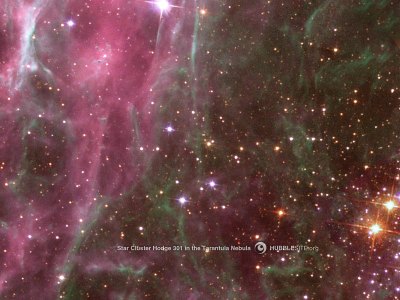STUDY: Vocabulary
Completion requirements
Vocabulary

Star Cluster Hodge 301. Photo courtesy of NASA. Public domain.
Black hole: the result of a massive star collapsing. Gravity acts so strongly on black holes that nothing can escape it.
Brown Dwarf: Collection of matter that could not achieve nuclear fusion.
Galaxy: biggest groups of stars and contain millions to billions of stars
Main Sequence: Longest part of a star's lifespan. Stars with larger mass have shorter main sequences. Stars with smaller mas have longer main sequences.
Nebula: vast, cold cloud of interstellar gas and dust
Nuclear Fusion: the process that forms stars, when H and He combine to create heavier and heavier elements.
Neutron stars: One of the last stages of a mid-sized star. Neutron stars have a core of densely-packed neutrons.
Neutron stars: One of the last stages of a mid-sized star. Neutron stars have a core of densely-packed neutrons.
Protostar: cloud of gas that is beginning the process of nuclear fusion.
Red giant: Stage in a star's lifespan in which it burns helium instead of hydrogen.
Solar Nebula Theory: theory that our solar system formed as a nebula of gas & dust began to collapse approximately 4.5 billion years ago
Supergiant: Another name for a red giant. Supergiants are larger than red giants.
Supernova: violent, luminous explosion or death of a very massive star
White Dwarf: Stage in which a star stops fusion. White dwarfs can have high temperatures, but they produce less light than a star in main sequence.
White Dwarf: Stage in which a star stops fusion. White dwarfs can have high temperatures, but they produce less light than a star in main sequence.
After you have completed this part of the lesson, you can check the box for this lesson piece in the course to mark it as complete
Last modified: Monday, 23 June 2014, 4:20 PM